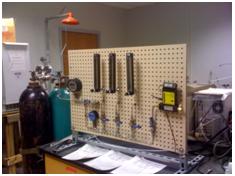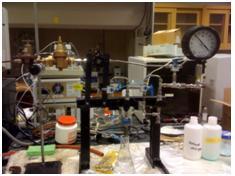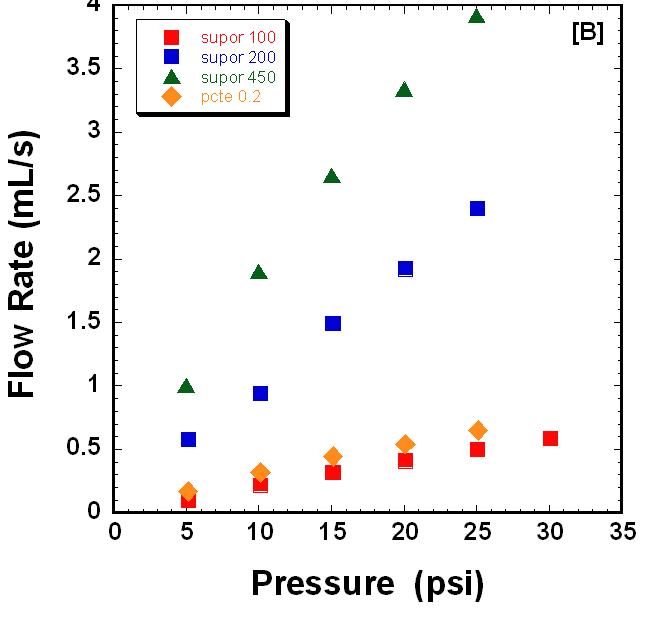Reports: G9
47954-G9 Latex Composite Ultrafiltration Membranes
This proposal seeks to overcome current difficulties in current membrane manufacture by utilizing the advantages of particle self-assembly combined with tailoring particle surfaces to fabricate membranes with a wide range of narrow pore size distributions and surface compositions. The focus will be to synthesize ultrafiltration (UF) membranes (10 50 nm in pore sizes) with higher fluxes and narrower pore size distributions than commercial membranes. By placing an array of colloidal particles on a porous support and stabilizing the array, the interstitial spaces between the particles serve as narrow dispersed pores for size separations.
This proposal has 2 specific objectives.
(1) To fabricate ultrafiltration composite membranes (membranes with pore sizes dp in the range of 10 - 50nm) from mixtures of colloidal particles via colloidal filtration on different substrates.
(2) To demonstrate advantages of particle assembly over traditional membrane fabrication methods as a strategy for membrane formation. This will be accomplished by examining classical separation properties such as pore size distribution and volumetric flux as well as their performance in terms of fouling, separation of model systems, stability and influence of surface composition.
Progress to Date
Till date, the following steps were worked upon
1) Recruitment of students: Erin Holley (female) - an undergraduate in chemical engineering was recruited in Fall 2008 to work on the project. Erin started work on setting up equipment for the gas and water permeability experiments. Erin graduated December 2008 and started graduate school (masters) Spring 2009 to work on the membrane project. She has been working on the project for the last 8 months as a master's student. Gary Brodeur was recruited to synthesize silica particles in Fall 2008. He continued work on silica synthesis during spring and summer 2009 and started graduate school (PhD) in my lab starting Fall 2009. Gary is however working on converting biomass to energy in graduate school and will use membranes synthesized by Erin for separations. Mayra Gonzalez (junior, Hispanic) was recruited to characterize and synthesize membranes during Spring 2009 and to work with Erin Holley. She was the recipient of the supplement award for minority students during summer 2009 from ACS PRF. Mayra will continue to work in my lab in her senior year and has plans of attending graduate school. Recruitment of students was key for progress on the project and it also has had a big impact on the student's careers.
2) Experimental setup of equipment for gas and water permeability: A considerable amount of time was spent by Erin in overcoming difficulties and in setting up the equipment for gas and water permeability measurements (Figure 1). Commercial membranes were then successfully characterized using the above equipment (Figure 2). Thus, we now have the capability to characterize membrane pore size and water permeability's in our capabilities and this will play an important role in characterizing latex composite membranes.
Figure 1: Experimental setup to measure pore size distribution and water permeability of membranes.
Figure 2: Pore size [A] and water flow of commercial membranes as measured with experimental setup shown in Figure 1.
3) Synthesis of Particles: Two different particles were synthesized in our laboratories and purchased from vendors. The two different particles are silica and polystyrene. Silica particles from 27nm to 165 nm were synthesized by Stober synthesis and characterized by dynamic light scattering by Gary Brodeur. Polystyrene latex of 650nm and 900 nm were synthesized by emulision polymerization by Erin Holley and characterized by Scanning Electron Microscopy (SEM) and Light Scattering. She is extending the recipe to synthesize 250nm and 1400 nm Latex particles. These particles have a glass transition temperature of 104oC. Latex particles of 100nm, 200nm and 300nm of glass transition temperatures around 40oC were also purchased from Dow Chemical Company. The goal now is to synthesize membranes from these particles and to tune the pore size and water flux by particle assembly.
4) Synthesis of Particle Based Membranes: Experimental setup for synthesizing membranes by filtration of particles onto a base support has been setup in our laboratories and Erin Holley is currently working on synthesizing membranes and characterizing them by SEM, water and gas flow. The goal again is to get the pore size into the 10-50nm range by using mixtures of particles.
5) Rheology of Silica Dispersions: Once the silica particles were synthesized, the diffusion and rheology of these particle dispersions which plays an important in filtration and processing was also investigated in collaboration with researchers at the University of Illinois. A paper resulted from this activity in Langmuir. Ongoing research efforts include collaborations with researchers at Johns Hopkins University in using x-ray photon correlation spectroscopy in studying particle dynamics.
Impact of Research
1) The research if successful will result in novel membranes with controlled pore size and enhanced permeability's than commercial membranes for separations.
2) Research on membrane formation has helped me develop three important collaborations which will be important in my career as a researcher a) Collaborations with physicists at Johns Hopkins University in studying dynamics of particles and their self assembly b) Collaborations with Dr. Joseph Schlenoff (Head of Department of Chemistry at Florida State University) in using novel polyelectrolytes coupled with particles to synthesize membranes for separations and 3) Peng Jiang at University of Florida to synthesize membranes by the method of spincoating and for use of these membranes in different applications. I expect to continue these collaborations will result in proposals being submitted to different agencies and in journal publications.
3) Two of the undergraduate students working on the membrane project are in graduate school now (Gary Brodeur and Erin Holley) and one senior undergraduate (Mayra Gonzalez) has plans of attending graduate school. Starting Fall 2009, another talented junior undergraduate Velencia Witherspoon (female African American 3.9 GPA) has signed on to work in my lab on the membrane project. Thus this research has had a big impact on the students and encouraged them to pursue a career in science.








